I might be interpreting them wrong, but looking at the LR4 step response, I assume the red trace is tweeter and woofer with correct polarity, right? So the first zig-zag is the tweeter, then there is a small bump and it starts to go negative before the woofer 'hill' comes. I think the woofer hill should ideally be a continuation of the positive going flank of the tweeter zig-zag, like the black LR2 step response (that looks good IMO), so looking at the time scale, I thought removing abt 0.2ms on the woofer on LR4 could do that. Should give a deeper null when inverted too, but with so much going on in the FR, it might not, depending on the XO frequency.I spent about an hour to set delay for LR4, and used same for LR2. My new laptop has only 2 usb ports, which makes this slow. I'll continue tomorrow. I set gating to 9ms for these, shorter should be used for timing setup.
Also my lab is too small for this, I don't aim for perfection now.
Would it be possible to introduce a little bit of asymmetry to even out the FR maybe? Maybe play around with some cardboard/tape/clay-type of material to see what happens? Have you tried listening to it, pink noise or some music? It does look like a challenge, to make FR 'flat', but if it can be made to sound ok it could be deemed 'good enough'?
Maybe where you live, it's 'only' $1.79 as of 11.2022 in the USA, but inflation is quickly 'ramping up' here, so imagine we'll catch up and maybe pass you PDQ if we have to keep poring billions into dealing with the Russian 'police action'.
Yeah, meant 1.98, New year eve is still in my fingers🥳Maybe where you live, it's 'only' $1.79 as of 11.2022 in the USA, but inflation is quickly 'ramping up' here, so imagine we'll catch up and maybe pass you PDQ if we have to keep poring billions into dealing with the Russian 'police action'.
But anyway, look at this BMS! It has some kind of cloth/damping around the edge, don't know if its back is covered all the way to the base of the horn.
Dip is there anyway...
I would try to use the dip from 1100Hz as a part of x-over and have an electrical steep crossing at 1500Hz and play with delay of woofer! Maybe that's what you have now Juha?
And wish a good continuing of the New year! Sun is shining here!!
https://www.bmsspeakers.com/index.php-121.html?id=bms_12cn680
Dip is there anyway...
I would try to use the dip from 1100Hz as a part of x-over and have an electrical steep crossing at 1500Hz and play with delay of woofer! Maybe that's what you have now Juha?
And wish a good continuing of the New year! Sun is shining here!!
https://www.bmsspeakers.com/index.php-121.html?id=bms_12cn680
Happy New Year!
I tested baffle shape and set delay more carefully. The 1,3kHz wiggle from the bass didn't change at all. I guess I must test horn edge cushioning next...
I ended with 0,28ms delay with LR2 and 0,30ms for LR4. Inverted polarity null is not perfect because of the interference of the woofer.
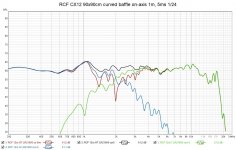

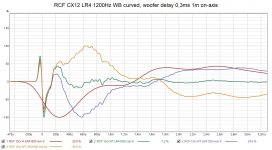
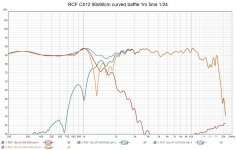
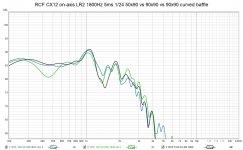
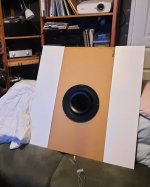
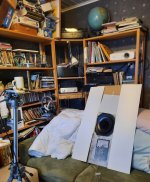
I tested baffle shape and set delay more carefully. The 1,3kHz wiggle from the bass didn't change at all. I guess I must test horn edge cushioning next...
I ended with 0,28ms delay with LR2 and 0,30ms for LR4. Inverted polarity null is not perfect because of the interference of the woofer.







I noticed, that I said that 1,3kHz wiggle didn't change. I meant in frequency, which would mean baffle width related interference. It did change in amplitude, which means it comes from the woofer's slot between horn and frame. Final speaker should have some kind of contouring, extension there. Breaking spherical shape would help too.
I've been thinking about making a full size curved test baffle from plywood sheets that I have leftover. When SLS-12 woofers arrive from Brno next week I can install them too and I must start using the living room for measurements. Outdoors is impossible during the winter.
I am semi-retired now, working only max. three days a week. And seems like my epilepsy is in control and depression is fading away!
I've been thinking about making a full size curved test baffle from plywood sheets that I have leftover. When SLS-12 woofers arrive from Brno next week I can install them too and I must start using the living room for measurements. Outdoors is impossible during the winter.
I am semi-retired now, working only max. three days a week. And seems like my epilepsy is in control and depression is fading away!
Last measurement with curved 90x90 baffle looks fairly close to RCF's datasheet. Judging by that, midbass has a bump between 700Hz - 1,3KHz centered slightly above 1kHz.
Cure that first and you'll have fairly flat response to 1800Hz. That will make x-over evaluation easier.
Regarding x-over, both choices are bad.
In a first case, you don't have enough slope, especially for midbass with slightly rising response above 1800Hz.
In a second case, x-over point is almost in a middle of problematic area where both drivers acousticaly interfere with each other.
Try 1800Hz 3rd order Bessel.
Or 1800Hz 3rd order Butterworth for midbass and 2nd Butterworth for tweeter.
Cure that first and you'll have fairly flat response to 1800Hz. That will make x-over evaluation easier.
Regarding x-over, both choices are bad.
In a first case, you don't have enough slope, especially for midbass with slightly rising response above 1800Hz.
In a second case, x-over point is almost in a middle of problematic area where both drivers acousticaly interfere with each other.
Try 1800Hz 3rd order Bessel.
Or 1800Hz 3rd order Butterworth for midbass and 2nd Butterworth for tweeter.
Yes, take the humps away from bass and horn first, then try to juggle the x-over. That functioned best for my coax.Last measurement with curved 90x90 baffle looks fairly close to RCF's datasheet. Judging by that, midbass has a bump between 700Hz - 1,3KHz centered slightly above 1kHz.
Cure that first and you'll have fairly flat response to 1800Hz. That will make x-over evaluation easier.
Regarding x-over, both choices are bad.
In a first case, you don't have enough slope, especially for midbass with slightly rising response above 1800Hz.
In a second case, x-over point is almost in a middle of problematic area where both drivers acousticaly interfere with each other.
Try 1800Hz 3rd order Bessel.
Or 1800Hz 3rd order Butterworth for midbass and 2nd Butterworth for tweeter.
Woofer problem solved!
The solution is very simple and based on wavefront and length behaviour around 1,3khz. A foam ring around the woofer makes the big interference go away, only some minor wiggles were left. These responses have the LR12 xo at 1800Hz and 1,3 kHz peak eq on. No need ro more eq and delay fine-tuning at this stage. Seems like this will be just ok! I have listened to music a little and yes, I do hear typical horn tweeeter sound, very sharp treble transients.
IRL I have some challenge to make the contouring ring to look nice. Material should be wood or plastic. Now I must start thinking if there is something premade... Fitting it with curved baffle won't be easy either.

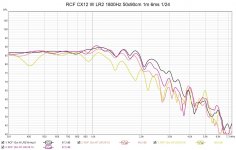

The solution is very simple and based on wavefront and length behaviour around 1,3khz. A foam ring around the woofer makes the big interference go away, only some minor wiggles were left. These responses have the LR12 xo at 1800Hz and 1,3 kHz peak eq on. No need ro more eq and delay fine-tuning at this stage. Seems like this will be just ok! I have listened to music a little and yes, I do hear typical horn tweeeter sound, very sharp treble transients.
IRL I have some challenge to make the contouring ring to look nice. Material should be wood or plastic. Now I must start thinking if there is something premade... Fitting it with curved baffle won't be easy either.


Nice progress!
Are you sure that a large radius like that is needed? Could just recessing the driver in the baffle be enough, or maybe mounting it from the back with a nice round over in the hole?
I know, it's easy to sit in the sofa and bombard you with things to try, but doing the actual tests takes a lot of time and effort 🙂
Are you sure that a large radius like that is needed? Could just recessing the driver in the baffle be enough, or maybe mounting it from the back with a nice round over in the hole?
I know, it's easy to sit in the sofa and bombard you with things to try, but doing the actual tests takes a lot of time and effort 🙂
Wheel trim ring, outer diameter 14" https://www.summitracing.com/parts/wvi-3000-14-1 is available from a Finnish shop too
Bicycle wheel rim 14" https://www.kunstform.org/en/salt-fraction-14-bmx-rim-14-inch-p-24864
Water pipe 2" https://www.jdpipes.co.uk/products-...ene-pressure-systems/drinking-water-pipelines
Decorative life ring https://www.amazon.com/Bilipala-Welcome-Cloth-Decorative-Nautical/dp/B01EMIOF3S
etc.
Bicycle wheel rim 14" https://www.kunstform.org/en/salt-fraction-14-bmx-rim-14-inch-p-24864
Water pipe 2" https://www.jdpipes.co.uk/products-...ene-pressure-systems/drinking-water-pipelines
Decorative life ring https://www.amazon.com/Bilipala-Welcome-Cloth-Decorative-Nautical/dp/B01EMIOF3S
etc.
There you have something to build the design theme from! -Maybe a smoke stack on top of the box, some maritime lanterns indicating overload etc 😀
I don't have open cell foam at home. Dacron doesn't stay in place, I could use small strips of tape. Actually horn response is satisfying as is.How about that foam in horn?
OK I made quick on-axis tests with the horn - dacron and tennis ball inserts. The first only attenuates, the latter makes awful diffractions.
One thing that is easily noticed with music, is that treble attenuates rapidly when the listener can't see the CD throat. My son says that he sits mostly at the spot anyway.
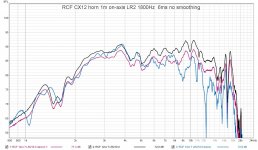
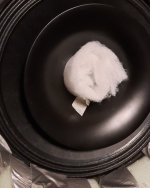
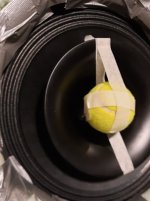
One thing that is easily noticed with music, is that treble attenuates rapidly when the listener can't see the CD throat. My son says that he sits mostly at the spot anyway.



I was recently reading a bit about Geddes (and others) experiments with foam in horns, after I saw it mentioned here, and I think the conclusion was that it does more on badly designed horns, and not as much on better designs. It would attenuate the output a bit, like 1dB or more in the top octave. I think Geddes mentioned that he had not found a way to measure the effect properly, the subjective improvement was more than the measurements suggested.
They also mentioned the foam should be open enough to let water flow through it, I think some foam for fish tanks was used. It should also fill the entire horn. Stacking foam disks of different diameters was mentioned.
Feel free to correct me if I'm wrong!
They also mentioned the foam should be open enough to let water flow through it, I think some foam for fish tanks was used. It should also fill the entire horn. Stacking foam disks of different diameters was mentioned.
Feel free to correct me if I'm wrong!
Excuse me, but what do you exactly mean with bass dip. I really don't get your idea. I have not even tried to measure and evaluate bass frequencies yet.I have suggested to put foam in horn to remove bass dip.
The horn of CX12 is polycarbonate, rigid structure. CD with 1" exit and the horn is not able to reproduce bass frequencies. Putting foam in the horn throat has absolutely zero effect to the cone woofer's response.
I have tested putting dacron wool between the horn and the cone, it had some attenuation effect to the woofer's 1.3kHz dip, but it was not worth mentioning. This same graph was in my post #66, green line is with dacron fill. I forgot to take a pic of it.
Does it mean that you have created a narrow bandwidth "Waveguide" for the midrange?Woofer problem solved!
The solution is very simple and based on wavefront and length behaviour around 1,3khz. A foam ring around the woofer makes the big interference go away, only some minor wiggles were left. These responses have the LR12 xo at 1800Hz and 1,3 kHz peak eq on. No need ro more eq and delay fine-tuning at this stage. Seems like this will be just ok! I have listened to music a little and yes, I do hear typical horn tweeeter sound, very sharp treble transients.
IRL I have some challenge to make the contouring ring to look nice. Material should be wood or plastic. Now I must start thinking if there is something premade... Fitting it with curved baffle won't be easy either.
View attachment 1125250
View attachment 1125251 View attachment 1125252
- Home
- Loudspeakers
- Multi-Way
- Big coaxial with RCF CX12N251